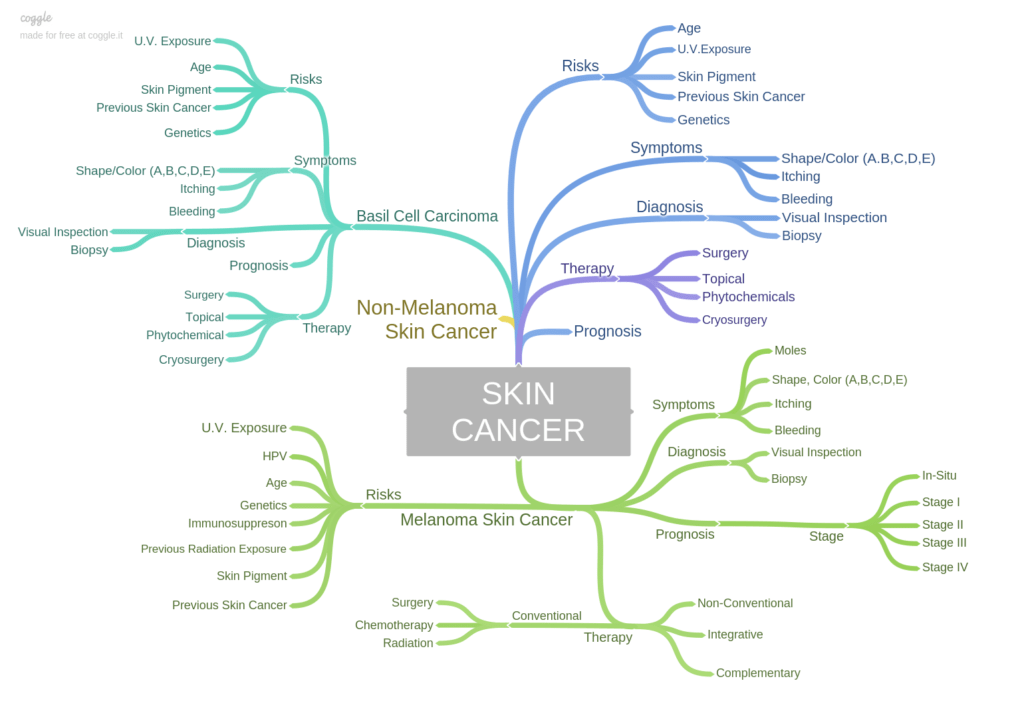Leave a Comment:
2 comments
[…] Skin Cancer Pain Itch? […]
Reply[…] Skin Cancer Pain and Itch? […]
Reply
If you’re reading this post you may be wondering if the itchy mole on your skin is skin cancer. According to the study linked and excerpted below, the itchy mole may be. Keeping an eye on your moles, freckles, etc. for changes is an important diagnostic tool. As far as it goes.
As you can see from “non-melanoma skin cancer at a glance,” there are many risk factors for skin cancer. I have six risk factors. I have a high-risk of skin cancer because of previous cancer therapies (radiation and a bone marrow transplant). If you suspect that the mole or freckle on your body may be cancerous you should do two things:
I’m not saying that you do or do not have skin cancer. What I am saying is that a dermatologist using a dermoscope is a more effective diagnostic method of identifying carcinomas.
When I recommend evidence-based, non-toxic therapies to reduce your risk of skin cancer, I’m saying that specific nutrition, supplementation and lifestyle therapies will help you feel better and look younger.
To learn more about other evidence-based therapies that can help prevent the development of non-melanoma skin cancer or relapse, please watch the short video below:
Non-Melanoma Skin Cancer at a Glance-
I am a cancer survivor and cancer coach. To learn more about evidence-based skin cancer therapies, both conventional and non-conventional, scroll down the page, post a question or a comment and I will reply to you ASAP.
Thanks,
“The purpose of the present study was to assess the prevalence and intensity of pain and itch among the 2 most common skin cancers…
Patients rated their pain and itch intensity on a visual analog scale from 0 (least intense) to 10 (most intense)…There were 353 biopsy-proven SCCs and 223 BCCs…
Itch was the most common symptom reported in both skin cancers (43.5% of SCCs and 33.4% of BCCs)…
The prevalence of pain was 39.8% in SCC and 17.7% in BCC. A patient’s pain score was a highly significant predictor of having an SCC as opposed to a BCC…
Comment- Our findings reveal that pain and itch are common symptoms of NMSC. A previous study reported tenderness in SCC,4 but to our knowledge, ours is the first study to assess the prevalence of pain and itch and their intensities in NMSC. Specifically, we have shown the intensity of pain to be a unique factor to help in differentiating SCC from BCC. This finding is of significant clinical utility in the diagnosis and treatment of NMSCs. With an increasingly aging population, patients often present with numerous BCCs and SCCs, and it is often difficult for the clinician to prioritize lesion biopsy and removal…”
“Patients sometimes have multiple lesions that are suspicious looking, and those that are itchy or painful should raise high concerns for non-melanoma skin cancers,” study author Dr. Gil Yosipovitch, chairman of dermatology at Temple University School of Medicine, said in a Temple University Health System news release.
Researchers looked at the medical records of 268 patients who were confirmed to have skin cancer lesions between 2010 and 2011. The patients were treated at Wake Forest University Baptist Medical Center and had almost 350 lesions in total.
The patients answered questions about the levels of pain and itchiness in their lesions. More than one-third of the skin cancer lesions itched, according to the study. Just under 30 percent were painful. Many people reported that their lesions were both painful and itchy.
Melanoma lesions were the least likely to be painful or itchy. Other skin cancers, especially basal cell carcinoma and squamous cell carcinoma, were more likely to be itchy or painful, the findings showed. Melanoma is much less common than basal cell and squamous cell skin cancers, but it is far more dangerous, according to the American Cancer Society.
[…] Skin Cancer Pain Itch? […]
Reply[…] Skin Cancer Pain and Itch? […]
Reply